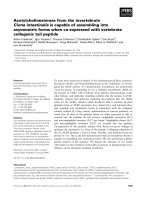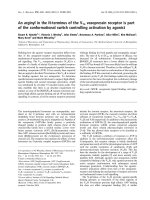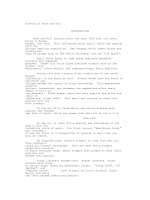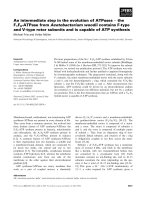Porosity is percent of rock
Bạn đang xem bản rút gọn của tài liệu. Xem và tải ngay bản đầy đủ của tài liệu tại đây (2.11 MB, 28 trang )
Aquifer
• Properties: Porosity,
specific yield, specific
retention.
• Potential: Transmissivity,
storativity.
• Types: confined,
unconfined.
• Hydraulic conductivity,
Physical Laws controlling
water transport.
Porosity
• Porosity is percent of rock or soil that is void of
material.
• n = 100 Vv/V
• n = porosity (percentage)
• Vv = volume of void space (L3, cm3, m3)
• V = unit volume of material including voids and
solids.
How to measure porosity
Density of a fluid
•
•
•
ρ = m/v (M/L3)
m = mass (M)
v = volume (L3)
Total Porosity
• n = 100 [1 – (ρb/ρd)]
• n = porosity (percentage).
• ρb = bulk density of aquifer material.
• ρd = particle density of aquifer material.
Factors affecting porosity
• Packing
• Grain-size distribution - sorting
Grain packing, grain size, and
porosity
• Cubic packing: n = 47.65%
• Rhombohedral packing: n = 25.95%
• Grain size mixture => porosity lowered.
Processes affecting grain sorting
• Well-sorted sediments
=> wind, running water, wave action …
=> higher porosity.
• Poor sorting
=> glacial action, landslides …
=> lower porosity.
• Grain shape
=> sphere, rod, disk, book …
Sediment Classification
• Sediments are classified on basis of size of
individual grains
• Grain size distribution curve
• Uniformity coefficient Cu = d60/d10
• d60 = grain size that is 60% finer by weight.
• d10 = grain size that is 10% finer by weight.
• Cu = 4 => well sorted; Cu > 6 => poorly sorted.
d60
d60
d10
d10
d60
d10
d60d10
Porosity of sedimentary rocks
• Diagenesis => compaction, removal or addition of
material, transformation of minerals by
replacement or phase change.
Porosity of sedimentary rocks
• Diagenesis => compaction, removal or addition of
material, transformation of minerals by
replacement or phase change.
• Primary porosity – pores between grains.
• Secondary porosity – fractures in rock.
• Clastic rocks – n = 3% - 30%.
• Limestones and dolomites – n = 1% - 30%.
Porosity of plutonic and
metamorphic rocks
• Weathering and fracturing – increase overall
porosity.
• Tectonic stresses - fracturing, faulting, folding.
• Fracturing increases porosity by 2% - 5%.
• Weathered plutonic rocks can have porosities of
30% - 60%.


![Tài liệu [ Team LiB ] Configuring Your Safe Senders List The Safe Senders list is part of the Junk E-mail pdf](https://media.store123doc.com/images/document/14/nu/js/medium_jsx1390245650.jpg)






